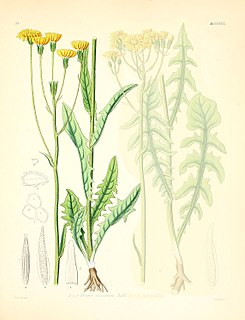
Crepis, commonly known in some parts of the world as hawksbeard or hawk's-beard, is a genus of annual and perennial flowering plants of the family Asteraceae superficially resembling the dandelion, the most conspicuous difference being that Crepis usually has branching scapes with multiple heads. The genus name Crepis derives from the Greek krepis, meaning "slipper" or "sandal", possibly in reference to the shape of the fruit.
Ribes tularense is a rare species of currant known as the Sequoia gooseberry or Tulare gooseberry. It is endemic to southern California, at elevations between 1,500–1,800 metres (4,900–5,900 ft).

Frederick Vernon Coville was an American botanist who participated in the Death Valley Expedition (1890-1891), was honorary curator of the United States National Herbarium (1893-1937), worked at then was Chief botanist of the United States Department of Agriculture (USDA), and was the first director of the United States National Arboretum. He made contribution to economic botany and helped shape American scientific policy of the time on plant and exploration research.

Crepis acuminata is a North American species of flowering plant in the family Asteraceae known by the common name tapertip hawksbeard. It is native to the western United States where it grows in many types of open habitat.
Crepis bakeri is a species of flowering plant in the family Asteraceae known by the common name Baker's hawksbeard. It is native to the western United States where it grows in many types of mountain and plateau habitat. It is found in Oregon, Washington, Idaho, northern California, Nevada, and Utah.

Crepis intermedia is a North American species of flowering plant in the family Asteraceae known by the common name limestone hawksbeard. It is native to the Pacific Northwest, Columbia Plateau, Great Plains and Southwestern regions of western North America.

Crepis modocensis is a species of flowering plant in the family Asteraceae known by the common name Modoc hawksbeard.

Crepis occidentalis is a North American species of flowering plant in the family Asteraceae known by the common names western hawksbeard, or largeflower hawksbeard. It is native to western Canada and the western United States.
Crepis pleurocarpa is a North American species of flowering plant in the family Asteraceae known by the common name nakedstem hawksbeard. It is native to the western United States (Washington, Oregon, northern California and western Nevada.

Crepis runcinata is a North American species of flowering plant in the family Asteraceae known by the common name fiddleleaf hawksbeard. It is native to western and central Canada, the western and central United States and northern Mexico (Chihuahua).

Crepis paludosa, the marsh hawk's-beard, is a European species of flowering plant in the tribe Cichorieae of the family Asteraceae. It is widespread across much of Europe with isolated populations in Iceland, the Ural Mountains, and the Caucasus.
Tetracoccus ilicifolius is a rare species of flowering shrub in the family Picrodendraceae known by the common names hollybush and holly-leaved tetracoccus.

Crepis tectorum, commonly referred to as 'the narrowleaf hawksbeard' or 'narrow-leaved hawk's-beard', is an annual or winter annual plant between 30 and 100 centimetres in height. Originating in Siberia before being introduced to Canada in 1890, the narrowleaf hawksbeard's is an invasive species. Maintaining one branched, hairless and leafy stem during maturity, the narrowleaf hawksbeard has yellow leaves which are arranged in an alternate manner and less than 0.5 inches (13 mm) wide.

Crepis barbigera is a North American species of flowering plant in the family Asteraceae. It is native to the northwestern United States. It has been found in Washington, Oregon, and Idaho.

Crepis biennis is a European species of flowering plant in the family Asteraceae with the common name rough hawksbeard. It is native to Europe and Asia Minor, as well as being sparingly naturalized in scattered locations in the northeastern United States and on the island of Newfoundland in eastern Canada. Many people think that they are dandelions because they look so alike but that is only because both are in the daisy family.

Crepis bursifolia is a European species of flowering plant in the family Asteraceae with the common name Italian hawksbeard. It is native to southern Europe, as well as being sparingly naturalized in California.

Crepis nicaeensis is a European species of flowering plant in the family Asteraceae with the common names French hawk's-beard and Turkish hawksbeard. It is widespread across much of Europe, as well as being sparingly naturalized in scattered locations in the United States and Canada.

Crepis pulchra is a European species of flowering plant in the family Asteraceae with the common name smallflower hawksbeard. It is widespread across much of Europe as well as in Morocco, Algeria, and western and central Asia. It has also become naturalized in the parts of the United States and in the Canadian Province of Ontario.

Crepis rubra is a European species of flowering plant in the family Asteraceae with the common name red hawksbeard or pink hawk's-beard. It is native to the eastern Mediterranean region and is widely cultivated as an ornamental. It became naturalized in a small region of the United States.

Crepis vesicaria is a European species of flowering plant in the family Asteraceae with the common name beaked hawk's-beard. It is native to the Western and Southern Europe from Ireland and Portugal east as far as Germany, Austria, and Greece. It became naturalized in scattered locations in North America.















